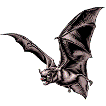Museum, University of Nebraska State

University of Nebraska State Museum: Mammalogy Papers
Document Type
Article
Date of this Version
June 2000
Abstract
No family of mammals has undergone a greater adaptive radiation than phyllostomid bats. Phylogeny combined with eco-morphological considerations of trophic structures can help understand this adaptive radiation and the evolution of Microchiroptera. Microchiropteran bats are overwhelmingly insectivorous, and constraints within the morphospace of insectivory have produced a dynamic equilibrium in bat morphologies that has persisted for 60 million years. The ability to eat fruit may be the key synapomorphy that allowed phyllostomids to escape insectivore morphospace and diversify. Although many phyllostomids have changed greatly, others that have maintained insectivory have changed little, which is equally remarkable.


Comments
Published in Evolutionary Ecology Research 2 (2000), pp. 317–335. http://www.evolutionary-ecology.com/
Copyright © 2000 Patricia W. Freeman.